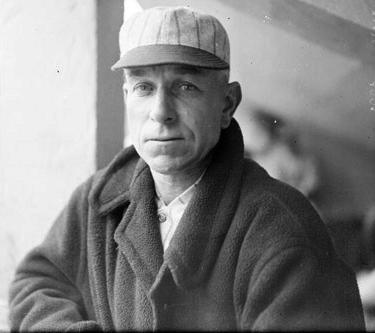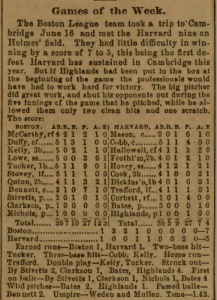Historical Hitter June 16, 1892: Hugh Duffy

The Batter of Yesterday was Hall of Famer Hugh Duffy, Sir Hugh Duffy as the Royal Rooters knew him.
 In 1892 Duffy batted second for the Beaneaters, and statistics show he hit a legitimate .301/ .364/ .410 with an OPS+ of 124; a worthy average. Yet, 1892 was the last year of the shorter mound distance of 55’-6.” It was the year of the pitcher. Last Year John Thorne did a very good analysis on pitching speed, and with the shorter distance gave the hitters less reaction time to the pitched ball. His calculations showed that the reaction time of that era was similar to facing 100 MPH fastballs on just about every typical pitch. The top three WAR leaders of the NL that year were all pitchers, led by Cy Young’s 13.1 and only two non-pitchers were the top 10 WAR leaders that season.
In 1892 Duffy batted second for the Beaneaters, and statistics show he hit a legitimate .301/ .364/ .410 with an OPS+ of 124; a worthy average. Yet, 1892 was the last year of the shorter mound distance of 55’-6.” It was the year of the pitcher. Last Year John Thorne did a very good analysis on pitching speed, and with the shorter distance gave the hitters less reaction time to the pitched ball. His calculations showed that the reaction time of that era was similar to facing 100 MPH fastballs on just about every typical pitch. The top three WAR leaders of the NL that year were all pitchers, led by Cy Young’s 13.1 and only two non-pitchers were the top 10 WAR leaders that season.
The next year the mound was pushed back to the distance it is today at 60’-6.” Duffy’s average jumped over 60 points to a very healthy and league leading .363/ .416/ .461 and an OPS+ of 126. The next season, was his greatest, and one of baseball’s greatest when he hit a record high .440 with an OPS+ of 173.
Never known as a nice guy or one to show a great deal of kindness to others, Ted Williams was mythically reported to have said that he hoped he never hit 441 and broke Duffy’s mark because he liked him so much. (Baseball-reference.com)
The game in question is of interest due to contemporary context of the College World Series, and the recent MLB Draft, with the underlying issue of defining amateurism. While the debates rages on today with billion dollar NCAA TV deals and full tuition of the two big money sports and the relative scarcity of funds for baseball scholarships the issue of amateurism is not new. The debate of the excess of College sport and paying of college age athletes was a concern way back in 1892. Sporting Life of June 25th of that year reported that creep of professionalism and the damage to college student-athlete amateur was significant issue that the Harvard Faculty issued an edict on their baseball team. Sporting Life reported:
It is slated on good authority that the Harvard faculty, through the advisory athletic committee, has issued an edict to the members of the Harvard Varsity Nine, who are hooked to play with the Boston Athletic Association team during the summer months, to the effect that if they play with this nine they will be debarred from representing Harvard on the ball field next season. The men so warned are Highlands, Wiggin, Upton, Cobb, Dickinson, Soule, Cook and Corbett.
How did the Harvard Nine respond? How do students respond to Administration objections?
Again Sporting Life reported: The Boston League team took a trip to Cambridge June 16 and met the Harvard nine on Holmes’ Field. They had little difficulty in winning by a score of 7 to 5….
(They played the professionals, and not just any team the 1892 Temple Cup (World Series Champs of 1892, the Beaneaters of Boston. Sporting Life did not mention either attendance or if a gate was charged.) So perhaps the team did not violate the edict of playing for the Boston Athletic association, they skipped BAA and perhaps ignored Faculty objections and just played the professionals.
 The Box Score shows that Beaneaters scored seven runs early and then did not seem to give it their best college try after getting a big lead. Of the twelve runs scored only two were earned, as the game featured seven errors, three wild pitches and two passed balls. What is also of great interest, the game took a total of 1 hour and 43 minutes, or about 5 innings of a game played today.
The Box Score shows that Beaneaters scored seven runs early and then did not seem to give it their best college try after getting a big lead. Of the twelve runs scored only two were earned, as the game featured seven errors, three wild pitches and two passed balls. What is also of great interest, the game took a total of 1 hour and 43 minutes, or about 5 innings of a game played today.
Baseball’s first superstar King Kelly hit a triple, and into a double play, while Harvard’s “amateur” Trafford hit a home run, it was Duffy who went 3 for 5 with all three being singles, thus garnering the batter of the day.
This was a game of baseball titans, the Beaneaters were the toast of the NL in ‘92, and it was the first loss of the year for the Crimson Nine.
